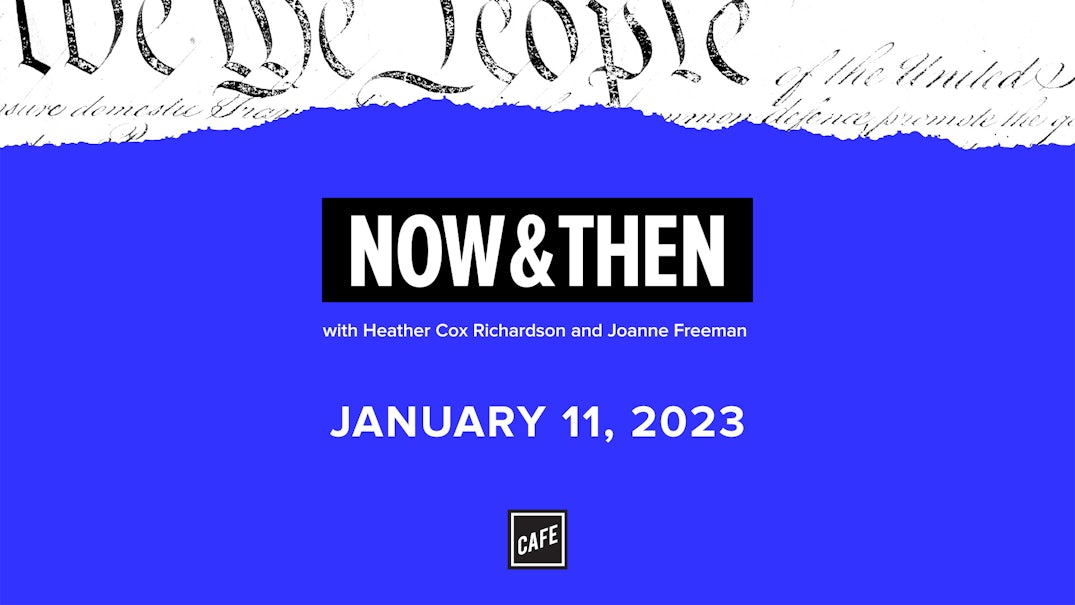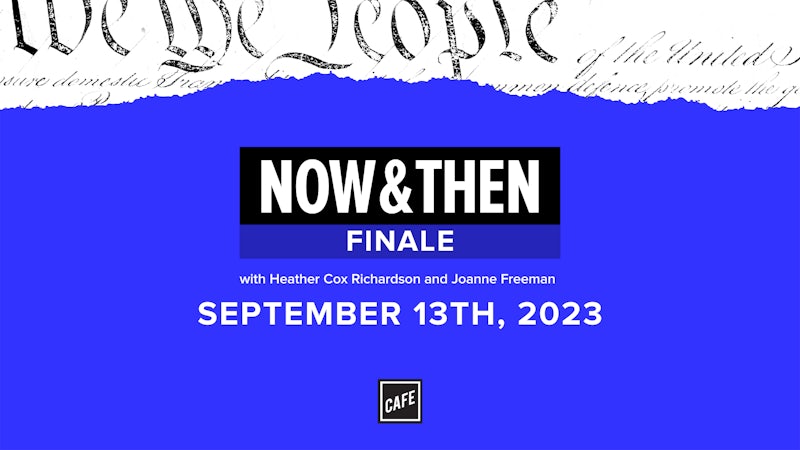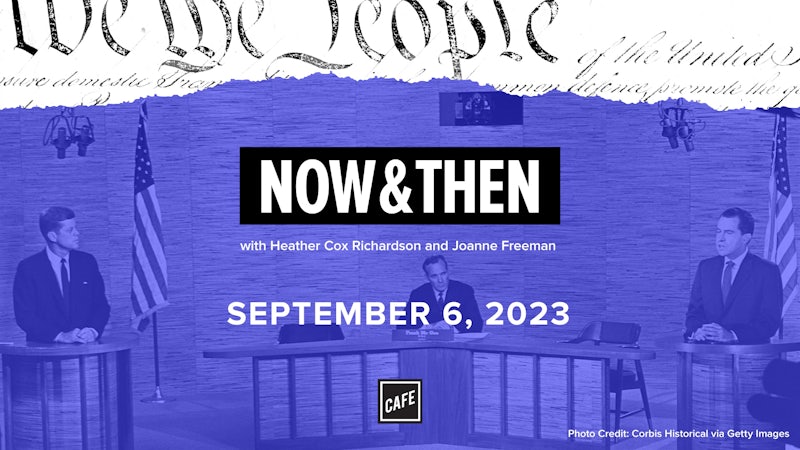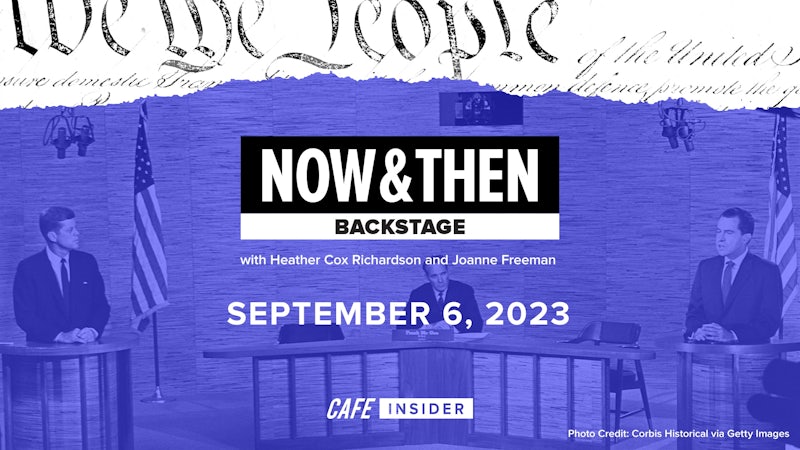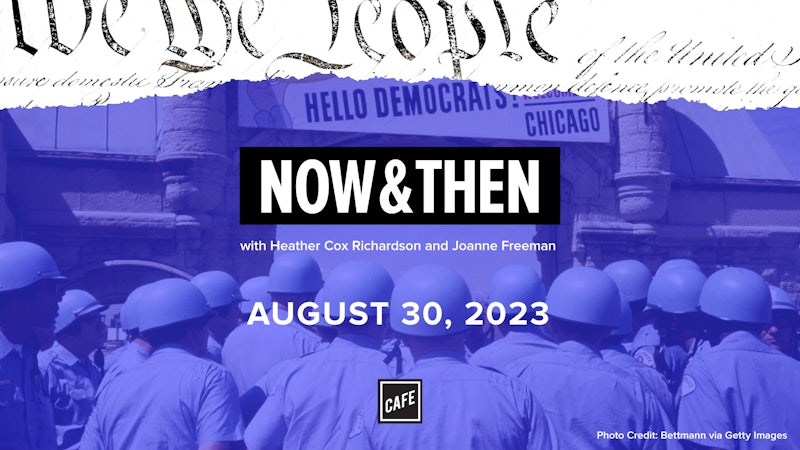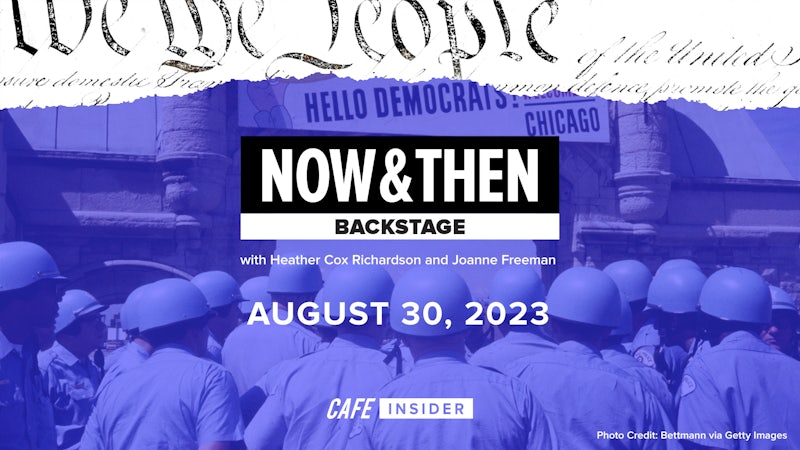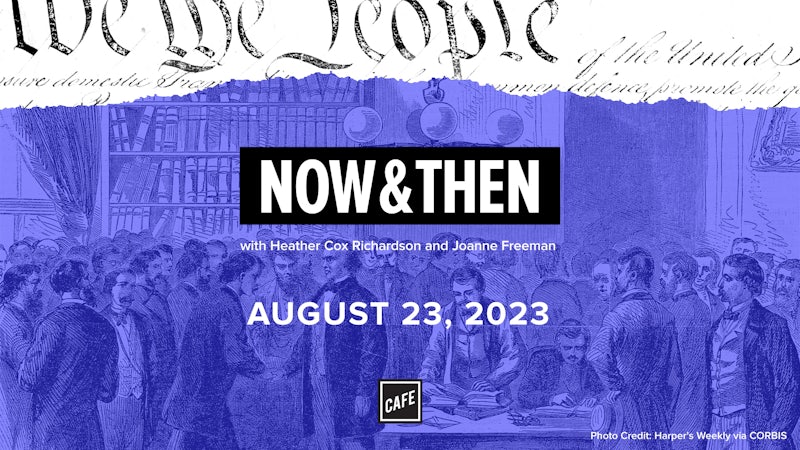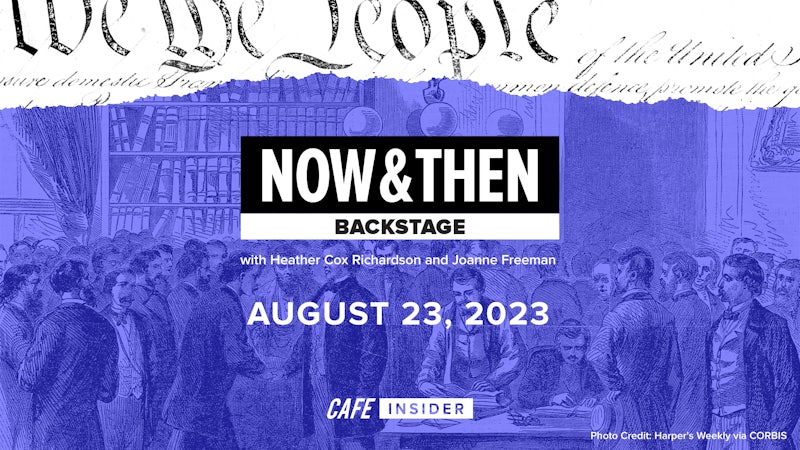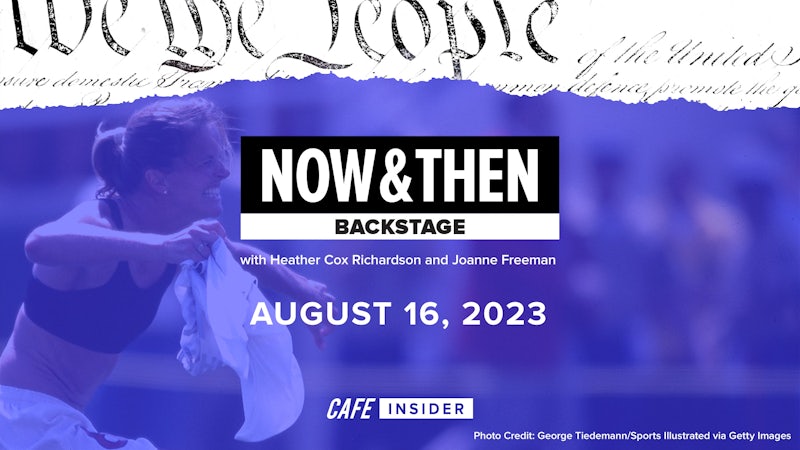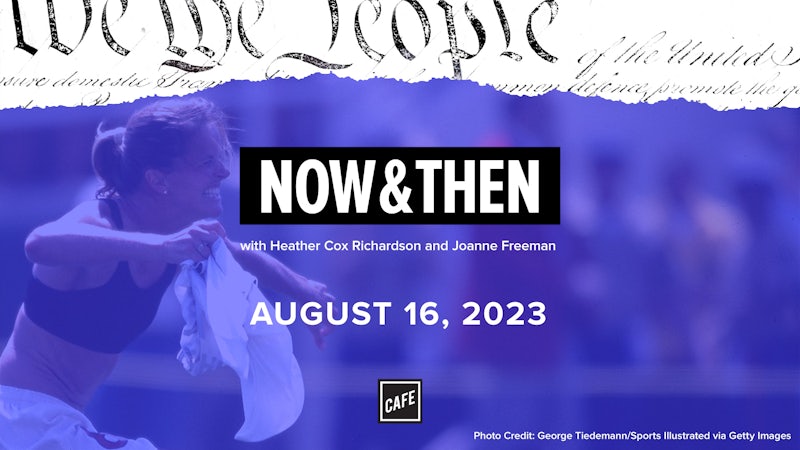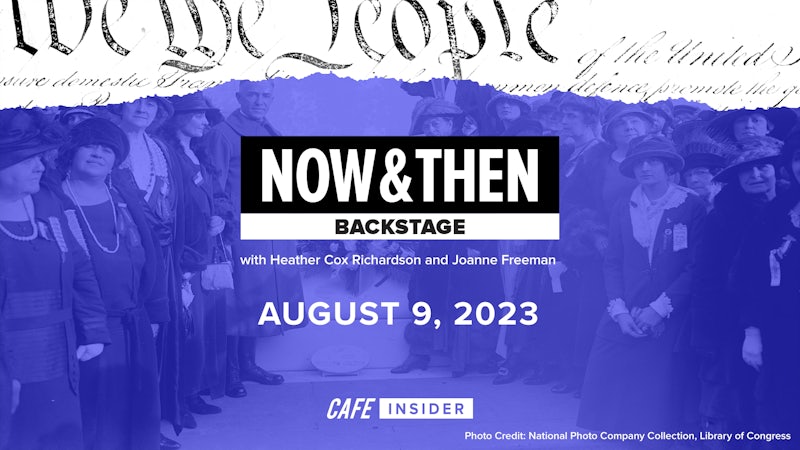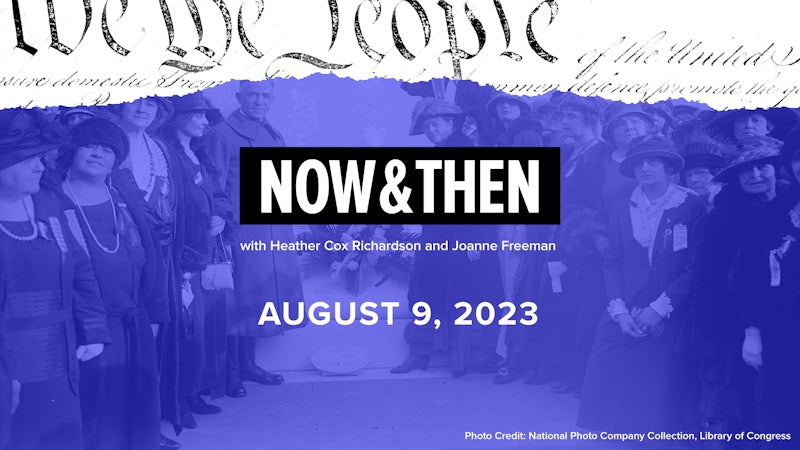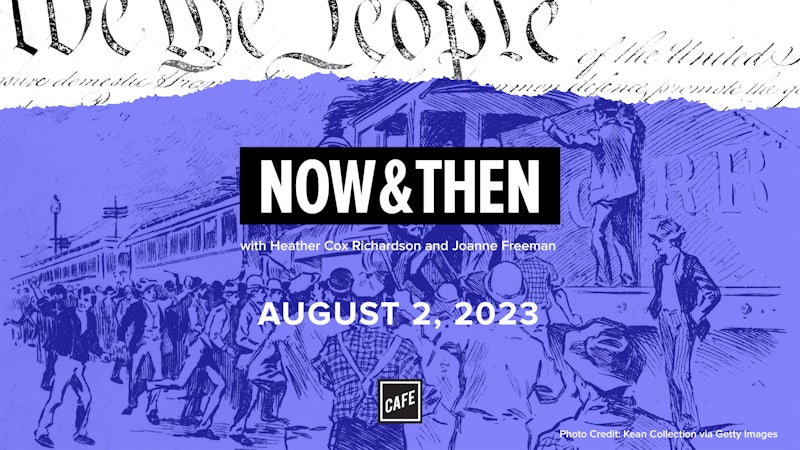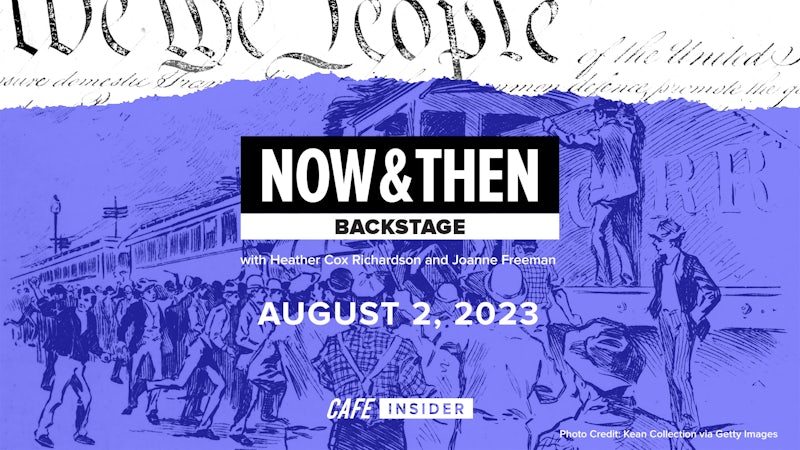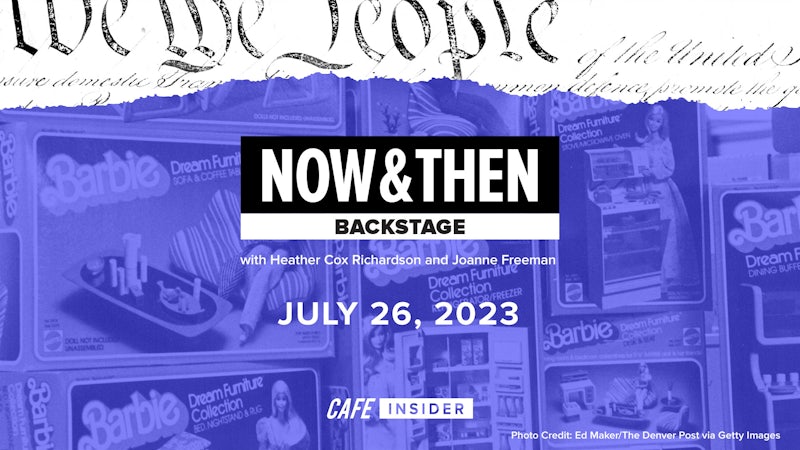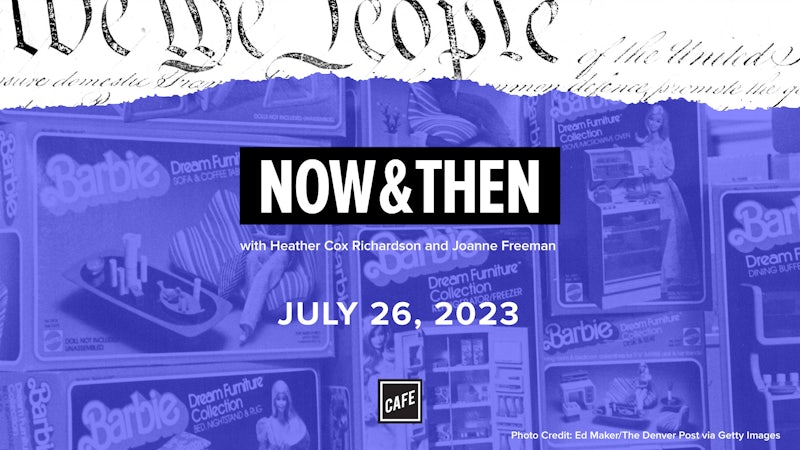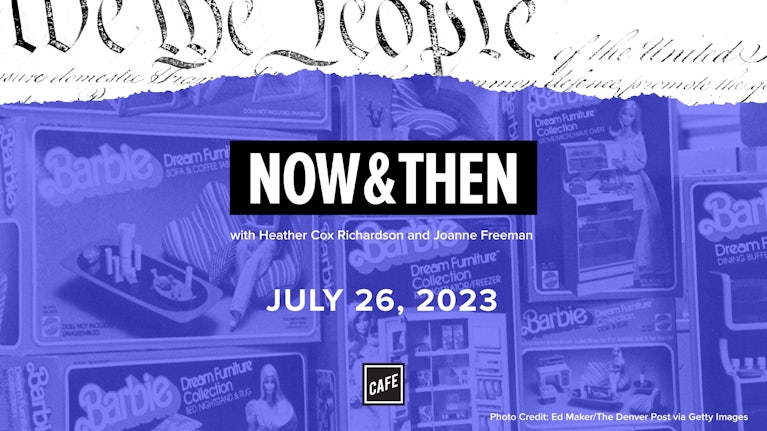Heather Cox Richardson:
From CAFE and the Vox Media Podcast Network, this is Now & Then. I’m Heather Cox Richardson.
Joanne Freeman:
And I’m Joanne Freeman. Our topic today comes from something that a bunch of us here at Now & Then noticed and were chatting about last week, and that is that there seemed to be a lot of end of year roundups looking ahead that seem to be cheerier, more optimistic than, certainly, we’ve been used to seeing at the end of several years in the past, when more than anything else, the end of year wrap-ups were sort of like, “We made it through that year.” So, one of the things that we were interested in exploring today is this very question, is what’s happening now? How can we explain? And how might history show us how to process why people are really kind of looking up about what’s coming down the pike, what does it mean, and perhaps what does it not mean?
Heather Cox Richardson:
Well, and I loved some of those. Well, first of all, Joanne, happy new year.
Joanne Freeman:
Oh yeah. Happy new year.
Heather Cox Richardson:
Although you and I have talked since the new year. And I loved those, all the cartoons, but one of the cartoons I liked best was all the people standing around a corner down a hallway from the door that said 2023 and, with a long stick, cautiously poking it open.
Joanne Freeman:
I saw that same cartoon and paused and laughed, because it just encapsulated, in one little image, what I think so many of us are feeling right now.
Heather Cox Richardson:
But one of the things that really jumped out, I think, to all of us on the team was how it feels, and I think the word feels is going to be important going forward. How it feels like we’re entering a new era. And that made us think about other times in which America appeared or felt to be entering a new era. And what we wanted to do today was look at those times, and maybe identify some of the ways in which historians look at a time and say, “Gee, this looks new.” And one of the things that jumped out at me when we were prepping for this is how many of those indicators are not necessarily ones that you think of when you think about a so-called new era. But we’re talking about the sorts of eras that are named, where people say, “Oh, we’re going into something new.” And we wanted to find some that we had not done before. So, we started with Thomas Jefferson. No, I’m kidding.
Joanne Freeman:
It’s the new year, Heather. We’re giving you a break.
Heather Cox Richardson:
Oh, I should be nice to Thomas Jefferson all year.
Joanne Freeman:
Oh, okay.
Heather Cox Richardson:
Oh, it’s going to be a short podcast season.
Joanne Freeman:
What I love about this, Heather, is that you have put me in the position of defending Thomas Jefferson, which, that’s not my normal position, but compared with you.
Heather Cox Richardson:
Okay, I promise you, I will try to be say good things about Thomas Jefferson all year. I shouldn’t have promised that.
Joanne Freeman:
No, and my eyebrows are very high above my glasses right now.
Heather Cox Richardson:
Well, so let’s start with something that, I don’t know, comes after Thomas Jefferson, so we don’t have to talk him.
Joanne Freeman:
Yes, yes. So, what came to be known as the Era of Good Feelings, which is what follows the end of the War of 1812. Now, the War of 1812 was significant, I suppose, significant and insignificant for a number of different reasons. Insignificant, in a sense, because it was a little bit equivocal as to what ultimately happened. It’s not as though, in reality, that the United States had a great victory. “Woo-hoo, the War of 1812 is over and we won.” However, what it felt like in the United States was there had been a revolution and the United States had come to be, and had fought against Great Britain and had won. And look, we did it again. This is great. What does it show? And when you look at things like popular culture, when you look at cartoons from the era, they all are have this kind of cocky assurance, like, “Look at us now. We survived the War of 1812.” Which they did. But the question here becomes, what are they feeling versus what’s actually happening? Which brings us to, why do we know it as the Era of Good Feelings?
So, one of the things that happens at the beginning of roughly this era is that James Monroe, newly inaugurated, June 1817, and he makes a tour of the Northern United States, which is something that Southern presidents tended to do in this era when they got elected. The first thing they would do is tour New England, because they wanted to say, “Hey, I’m president of you too.” So, Monroe does the Southern guy in the North tour, and he’s welcomed, and he’s celebrated. Again, people are kind of happy because the end of the War of 1812. And so, a newspaper from the period, the Colombian Sentinel, July 12th, 1817, has this comment in it from the editor Benjamin Russell. “During the late Presidential Jubilee,” which is what they were calling his sweep through the north, “many persons have met at festive boards in pleasant conversation, whom party politics have long severed. We recur with pleasure to all the circumstances which attended the demonstrations of,” drum roll please, “good feelings.”
So, here we are, beginning this post-War of 1812 era, with people actually literally feeling good. What they did with that, one of the noteworthy things that happens right at that era, it’s actually the same year that Monroe is inaugurated. That’s the year when Congress commissions John Trumbull to paint the huge portraits that are in the rotunda in the Capitol. And the idea, very explicitly, is, “Let’s look at that other time we fought Great Britain. Let’s look at the revolution. It’s wonderful and victorious and noble, and we will get those paintings up in the Capitol,” which needs to be fixed up a little bit, because the British weren’t particularly nice to Washington during the War of 1812.
Heather Cox Richardson:
They burned it, didn’t they?
Joanne Freeman:
Well, yeah. I was being diplomatic.
Heather Cox Richardson:
Just checking.
Joanne Freeman:
Yes. They did. It was a problem. But they’re fixing it up anyway, so it’s not as though, in a sense, Congress said, “We shall now bestow on the public.” It’s more like, “We have to do this, but isn’t this a great time to be patriotic in this way and to have the arts celebrate how we’re feeling right now?” And all of you have, I’m sure, those images in your head, even if you don’t know you do. The signing of the Declaration of Independence, the surrender of General Burgoyne, the surrender of Lord Cornwallis, and then General George Washington resigning his commission to Congress.
Heather Cox Richardson:
I think it’s an important theme for era changes. That is, they are times in which the country reaches into its past and tries to redefine, sometimes in very positive ways, sometimes in not so positive ways, what it means to be an American. And that, often, is associated with a changing demographic. The old guard is walking off stage and the new guard is coming on. So, isn’t it 1824 when Lafayette does his tour of America, and everybody’s like, “Oh, we were there, we were there”?
Joanne Freeman:
Yeah. Oh, my gosh. The celebration of Lafayette when he comes back, because he’s the revolution sort of personified, wandering around. And, again, it’s only a few years after this moment. So, yeah, in celebrating Lafayette, Americans are celebrating themselves, really. I want to add on to what you said, though, Heather, which is, you’re totally right that at these moments of change, people look back and grab at their history. But I think they also look ahead and try and figure out what they can do in a moment of change to shape things in a way that they consider to be better.
Heather Cox Richardson:
I think that’s exactly right. And you reach to the past to redefine a future. And there’s a new generation that does that. So, one of the other things that’s really dramatic about the Era of Good Feelings is the rise of the post-revolutionary generation. In 1820, it sure looked like all of them were staunch nationalists. You got Henry Clay coming out of Kentucky, who is a staunch nationalist, who tries to figure out a way that the government can support manufacturers, for example. I mean, coming out of Kentucky, the Virginia and Kentucky resolution’s where they said, “No, you can’t do anything that isn’t enumerated in the Constitution.” He’s like, “Yes, you can.” And even John C. Calhoun is a nationalist in the early 1820s. But the one that really jumps out to me is Daniel Webster. I mean, Daniel Webster becomes the voice of the American people. And it’s a name that probably people remember, Daniel Webster, but he’s from New Hampshire. He is a very heavy drinker.
Joanne Freeman:
He did have his own private wine cabinet in the Capitol, that was known, the wine closet of Daniel Webster.
Heather Cox Richardson:
But he articulated a nation that was going to be perpetual, that was really going to manage to continue, which the revolutionary guys were not at all convinced would happen. And Daniel Webster, and he’s not the only one. But my point is that there is often the rise of one or more extraordinary orators who are able to articulate a set of values going forward that redefine the country.
Joanne Freeman:
And that, especially in this era, if you’re talking about art in the Capitol, and you’re talking about congressional oratory in this time period, people paid much more attention to what was going on in Congress, and read entire speeches in newspapers. The presidency wasn’t at the center of everything in this time period. So, Webster giving those kinds of speeches was a big deal, was a public statement. Students memorized for a very long time some of his speeches that they delivered in classrooms, because they were absolutely an indication of this great nationalism, the United States, a great nation, again, coming out of the War of 1812. Now and forever, the union. That very much represented a different side of the Era of Good Feelings.
Heather Cox Richardson:
And there is also, in the twenties a new America-focused literature. And you and I have talked here before about things like Letters from an American Farmer in the 1700s, and some of the early stuff. But what really jumped out to me when I was thinking about the literature and the art of this period, because I think what we’re going to find out here is that there is often a new kind of art in a new period. And what really jumped out to me, first of all, was Washington Irving’s Rip Van Winkle. So, Washington Irving published Rip Van Winkle in June of 1819. The whole point of Rip Van Winkle is that he falls asleep because he listens to the little dudes playing in the woods. And that’s the CliffNotes version. I haven’t read it in a lot of years.
Joanne Freeman:
Little dudes playing in the woods.
Heather Cox Richardson:
Isn’t that right?
Joanne Freeman:
Don’t put that in your notes, kids.
Heather Cox Richardson:
But he falls asleep, and I forget for how long, you’ll remember. But when he wakes up, the whole world has changed so extraordinarily, he can’t recognize it. And the whole point was, oh, wow, look at how much America has changed, that this one man slept through the last however many years, and now he can’t even recognize where he is. But then, after Rip Van Winkle is a series that, to me, is really the heart of American definition in this period, is James Fenimore Cooper’s Leatherstocking Tales.
Joanne Freeman:
I knew you were going there.
Heather Cox Richardson:
So, do you like those books?
Joanne Freeman:
I like them as a historian. I like them because, for all the reasons you’re suggesting here, Heather. They’re fascinating to read. They’re very much of that moment.
Heather Cox Richardson:
They’re problematic in ever so many ways. And Mark Twain has that wonderful send-up of them where he’s just like, “These are the stupidest things I’ve ever read.” So many people find them hideously boring, and I get that. But they are the story of a man and his interactions both with the spread of Euro-American culture into Indigenous cultures, and how a nation, embodied in this guy, sees that. He’s really experimenting, I think the first one of those is 23, with what America is. And those books were defining books.
Joanne Freeman:
I suppose in one way or another, what we keep coming back to, even just starting out here, in this Good Feelings-ish Era, post-War of 1812, is in the arts, in the realm of politics, in even demonstrative politics with the Grand Jubilee tour of Monroe, you have people who are really happy that a war has ended. I’ll throw in the mix that the Federalist Party, which had been in power for a long time and had been fading on a national level for a long time, pretty much fades out on a national level in this time period. And they are the party that’s very top down, big government, not necessarily happy with democracy.
That’s yet another plank you can put in this understanding of this time period that feels different to people, and that feeling encourages these kinds of statements, this kind of art, which then feeds back on the feeling. And just as you said, Heather, add to that the fact that in this era, you have a lot of the people from the founding generation dying out. So, 1826, Jefferson and Adams dying on the same day, and Americans saw that as a providential sign. “They looked down from the heavens to show us how special we are.” I know, I mentioned Jefferson, I’m sorry. [inaudible 00:14:14]
Heather Cox Richardson:
I’m sitting here killing myself, going, “I’m not going to say it. I’m not going to say it.”
Joanne Freeman:
I can see it on your face. See, this is the thing. This is what the people listening don’t see, is me sometimes trying not to laugh, and you having your Jefferson face.
Heather Cox Richardson:
But so, Joanne, I told you that I was going to tease you during this episode.
Joanne Freeman:
You did, and I’ve been waiting.
Heather Cox Richardson:
Well, here it is. We have not yet discussed the most important signature of an era change. On March 15th, 1820, the entire union changed dramatically for the better. Maine enters the union as a state. I got a [inaudible 00:14:53] connection for every one of these. And it wasn’t easy.
Joanne Freeman:
Just so I can say, I have to fill in, the folks listening here. Before we started, Heather said, “I have something that I can tease you with for the entire episode, and I’m not going to tell you what it is.” And I’m imagining, I don’t know what I imagined, but this is not what I imagined. But sure enough, now I know what it is. Maine. This is going to be a little Maine thread traveling through the episode. I feel actually safer than I did before, when you first said that.
Heather Cox Richardson:
You’ve got two legs up now. You’ve got me to not say bad things about Jefferson, and now you know what’s coming at you. So, the next obvious era change to think about is the 1850s. And we’ve done the 1850s so much. We were both like, “We don’t want to talk about the 1850s,” this, the beginning of a new year.
Joanne Freeman:
Kind of living through part of it too.
Heather Cox Richardson:
Exactly, exactly. So, the next major era change that is named in the books, if you will, is the transition to the Progressive Era. And what’s interesting about the Progressive Era in this context is, first of all, that many people, and I can feel historians’ heads exploding around the country when I say this, but many people don’t have a clear definition for what the Progressive Era is. And they point to a number of different things that happened in society that made it clearly different than what had come before, and clearly different than what came after, but had very different starting points. So, one of the things that may be helpful when we think about the Progressive Era is to look at some of the things that we just talked about as defining the Era of Good Feelings and then carrying them forward, rather than trying to take the Progressive Era as what historians have tended to say about it.
So, there are some important things about the Progressive Era. And that is, first of all, the dramatic rise of industry and its concentration. So, one of the most dramatic things is after 1865, the number of patents that are awarded in America is extraordinary. The number of patents just jumps off the charts, and what that means is that there’s a lot more industry, there’s a lot more factories, and eventually, there’s a lot of consolidation. So, between 1897 and 1904, more than 4,000 American companies were consolidated into just 257 corporate firms, for example. And by 1904, just over 300 trusts. And a trust is a aggregation of companies and corporations, which are actually not the same thing, but for our purposes, it’s just a consolidation. They had about 40% of the country’s manufacturing assets, and had just a staggering capitalization of about $7 billion. Now, what that means is that, if you are a consumer, you feel, there’s feel again, that you are beholden to the trusts, especially in the pieces of your life that you really need.
So, sugar, for example, is the biggest trust. Oil. But even things right down to tin, for example, which is going to be what makes up the bucket that you milk Bossie into, and the bucket that you take food to work in and all that, and then the pans you bake with. And jute, which is the fibers that make up the bags that people put cotton into when they pick cotton, it’s also what is used in binders of things like the reapers on the western fields. And the jute ties up the harvest, and if you don’t have jute, you can’t use a machine because if you try to use wire, it splits and turns into shrapnel. So, the fact that every aspect of your life is going to be controlled by these things is really going to make a difference. The reason that I’m emphasizing that to the degree I am is because technological change, once again, is usually a harbinger of a new era, something changing. And here we have the rise of industrialization.
Joanne Freeman:
And then, we have a change. I mean, we talked before about, I suppose, a war ending in the United States surviving. Here we have this dramatic shift economically, and in the ethos of the United States at the time, in a way that people will notice. So, indeed, it does make sense that in experiencing what that feels like and trying to grapple with what it means, you move gradually into what becomes known, after the fact, actually, as the Progressive Era. So, the Progressive Era ends up being this moment of reform in the face of all of this change. Reform in society, reform in big business. Reform in just the lives of average people. It is a direct response to what came before. And the spirit of it, much along the lines of what we just talked about, the spirit of it is, things are moving for the better, things are shifting for the better. We can make things better. We’re in a different place than we were before.
Heather Cox Richardson:
And, once again, there’s the demographic change of the Civil War generation dying off, and the rise of younger people trying to take the stage. There’s also the rise of great orators. This is the period of William Jennings Bryan from Nebraska, who takes on the idea of trusts and begins to articulate a vision about what America should be. It shouldn’t be working only for the industrialists. It should be working for everybody. It’s the era of Theodore Roosevelt, who is also a powerful speaker, which always kind of astonishes me, but so it goes, where he is also articulating a different vision for America.
And while we have tended to forget him nowadays, it’s Albert Beveridge who was, at the time, considered one of the best orators in the world, talking about what it means to be an American and what it means for the country to grow and change. And the reason I wanted to mention him is because, this period, to me, is a great example of what we started out saying, and that is that eras that seem new, that seem to be a change, are not always positive. There is always some kind of, either a backlash, or in the case of Beveridge, a front lash to them. That is, he is a staunch imperialist. But that demographic change, you were talking about how people envision their history, and they want to move that history into the future. And some people want to move forward an inclusive, progressive history, and some people reach to their pasts and say, “Let’s go the whole traditionalist white supremacist route.”
Joanne Freeman:
Let’s go back there, when things were, quote unquote, “better.”
Heather Cox Richardson:
Yeah. And so, this is also the same period when we get the rise of the Confederate statues, and the lionization of the Confederate soldier, and Jim Crow, and all of those changes. All of which, all these changes had been in the works, of course, since at least the 1870s, but they really come to fruition in this changing moment.
Joanne Freeman:
The other half of that, of course, is you have a glut of non-fiction and fiction writings that are aimed at exposing some of the things that are profoundly unfair and often invisible in American society. So, you have in 1890 Jacob Riis, How the Other Half Lives, which is about poverty and tenement houses. You have 1904, Ida Tarbell, who writes The History of Standard Oil. John D. Rockefeller Senior’s aggressive, nasty business tactics. 1905 you have Upton Sinclair’s The Jungle, which is a fictional look at the brutality of the American meat-packing industry, and which helps to institute change, helps to move things towards the, ultimately, Food and Drug Act, in which there now needs to be inspections of US meat products, and helps make it illegal to sell tainted foods and medication.
All of that, at the same time as these other things that you just mentioned. All of it, in one way or another, a response to a sense of change, and in that sense of flux, people really wanting to shape things. And as we started out by saying, and I’m sure we’re going to loop back here again, change can be good. Change doesn’t have to be good. We started out by saying these are moments when people feel change and it’s good. It’s important to interrogate that and what that means, and who’s claiming it’s good, and what they think is good.
Heather Cox Richardson:
Well, and the other piece of the Progressive Era, that was one of the first pieces I learned, and completely blew me away. And that’s that if the 1820s gave us a new kind of literature, 1913, and generally people think of the Progressive Era as stretching on either side of 1900. The 1913 Armory Show in New York City, which introduced abstract and modern art to America, was mind-blowing. It changed everything. And I remember being in college and learning about the Armory Show and being like, “Who cares? Paintings,” right? Because I’m probably a sophomore or something, and didn’t know anything about anything. And then you learn about what it meant, not just for artists, but for everyone, to recognize that art did not have to be wooly trees and sheep. It could in fact be cubism or abstraction.
And, of course, I have grown to absolutely love abstract art. I don’t understand it at all, but I love it. And you think of what that meant. I always think of, the Ferris wheel is also from a little bit earlier than this, in the 1893 Columbian Exposition in Chicago. And we think now, “Yeah, I’m going to take the Ferris wheel. No, I’m going to take the Zipper.” Whatever, we’re much more exciting now. But if you had never been off a farm, to get into a metal contraption and have it take you where the birds flew, that is astonishing. That is an astonishing change. And that sort of change in this era, where people’s perspectives changed. I mean, you could not see the Armory Show and go back to wooly trees. You just couldn’t. You might like them still, but you had to understand there were different perspectives.
Joanne Freeman:
And some of those wooly trees would’ve been in another thing that rises in this time period, and that’s the Metropolitan Museum of Art. That, as a museum, comes to power and is seen as a museum with a mission. Henry Watson Kent, who was first the assistant secretary and then on the board of trustees for that museum, his big goal is to make museums for society. And here’s a quote that he said. “Art for art’s sake has no place in a healthy republic. Art for the people’s sake is the motto of the American museum today. Art for the enjoyment, for the study, and for the profit of the people is the cornerstone of the museum edifice, the object of its collecting exhibition and demonstration.”
So there, in a different way, he’s revolutionizing how people are engaging with art. He creates a visitor centere, he creates the first free tours. Classes can come to the museum for free. It might not be the way in which people are looking at art that’s changing. It’s the fact that different kinds of people can look at it, and can engage with it and can process with it, and it isn’t up on a platform away from people. It ends up being seen as part of a civic mission.
Heather Cox Richardson:
And part of that changing attitude and idea is the belief that government should react to the people. So, we get the rise of a different kind of government, in both parties, by the way, with the idea that the government really should react to the needs of ordinary Americans rather than simply trying to promote big business, trying to promote economic growth with the idea that that would trickle down to everybody else. And I mentioned that dramatic change in politics, Joanne, for a very specific reason. Don’t you want to know how Maine is involved in this change?
Joanne Freeman:
I should have not even waited, Heather. I just should have said, “And Maine?”
Heather Cox Richardson:
So, the election of 1884 was a really big deal in setting up the political change of the Progressive Era, because it was that election where a number of Republicans jumped ship and voted for the Democrat because they believed that the Republican Party had become way too corrupt. And that was the election where Theodore Roosevelt and Henry Cabot Lodge and Bob La Follete and many people who went on to become major progressive figures recognized that they had to reform the parties from within. That was also the same on the Democratic side. That’s the election where they stop paying close attention to the Confederacy and start to try and look at the urban cities by running Grover Cleveland. And the reason that everybody jumps to Grover Cleveland in 1884, the Republicans who do that are called Mugwumps, are because the Republican candidate is perceived as being extraordinarily corrupt and they can’t stomach voting for him. And he, of course, is Blaine, Blaine, James G. Blaine, the continental liar from the state of Maine.
Joanne Freeman:
State of Maine.
Heather Cox Richardson:
I can’t tell you how hard I worked on this all morning, Joanne.
Joanne Freeman:
You had this look on your face, and it made me nervous. I feel much better,
Heather Cox Richardson:
Just wait until we get to the 1960s, because that one, I almost ran ashoal on that one. But if we’re looking at the change in era and the change in tone, and especially the change in art, we’ve done literature, we’ve done fine art, but the next change is really characterized by something entirely different.
Joanne Freeman:
Indeed. And the first thing that one might think of if you’re talking about change in the 1960s is, not surprisingly, the Beatles. Basically, by November of 1963, they’re a huge sensation in England, but they’re really, at that point, not well known in the United States. So, on December 10th, 1963, which is just 18 days after President Kennedy’s assassination, CBS news anchor Walter Cronkite decides that he’s going to air this segment about the Beatles. They had been wanting to air it before, they put it aside to some degree because of what was happening with the assassination of a president. So, they air it. And it causes a sensation in the United States. For example, a 15-year-old named Marsha Albert watches this broadcast in Silver Spring, Maryland, and she writes to a DJ in Washington, “Why can’t we have music like that here in America?”
On December 17th, 1963, DJ James retrieves the hit single from the Beatles, I Want to Hold Your Hand and introduces it on air, and that marks the first American Beatles airplay, at which I have to say, (singing) Because I haven’t gotten to sing for a really long time. And that’s my only chance. So, thank you, ladies and gentlemen, for humoring me. But that’s a huge, huge sensation that marks, to many people, a big kind of cultural change. It’s a different kind of music, from a different kind of people. That 15-year-old girl noticed, that’s a different kind of music. Why can’t we have that kind of music here? In this moment, in the sixties, coming from the much more buttoned-down era of the fifties into a very different era, of the 1960s, this music was part of that wave, but it made it alive.
Heather Cox Richardson:
And I’m laughing here because this was such a huge deal that, when we say the Beatles, I don’t think probably any of our listeners need to know about whom we are speaking. And yet, I’m a little bit laughing because our notes actually tell us who the Beatles are. And anybody who lived through that era is like, “We got it. We got it, actually.” We know who they were, and could probably tell you, even if you’re not a huge fan, many things about their past. But one of the things that really jumps out, again, in the notes, is that when the Beatles came to the US in February 1964, about 40% of the US population, 73 million television viewers, listened to them on the Ed Sullivan Show. They played on February 9th, 1964, and 50,000 Beatles fans tried to get there. There were only 728 seats in the show’s studio, but 50,000 people tried to get them. Which, again, would have to think about the limits to that. That has to be people who felt that they could get to the theater that day.
Joanne Freeman:
And felt the need to, right? That’s the other thing. It’s like, on the one hand you can say, “Oh, I wish I could be there.” But these are people who took that move and felt they needed to be there. That’s pretty amazing. And I will bet that most people listening, in one way or another, have the images in their head of screaming girls responding to the Beatles, that same spirit that drove those 50,000 Beatles fans to try and get into that studio.
Heather Cox Richardson:
Well, and that screaming mattered, because, people talk about the boomers, and there’s such a big difference in the baby boom between the people who were born in the forties and the people who were born in the sixties. It’s almost a completely different era. I mean, they’re grouped together, but the idea that girls would scream at boys, with all the overtones that were part of that, was horrifying to a lot of parents. It’s like, “What happened to Susie, that this British invasion is turning my little girl into a fiend for boys?” So, that was a big deal.
But ,once again, this has all the hallmarks of a demographic change. The World War II generation is still very much in place, but John F. Kennedy certainly represents a young, vibrant future. And he gives an inaugural address that talks about everything that America can do for the world going forward. Now, really dramatically, in that address, he doesn’t mention race. And that’s very obvious to people like James Meredith who’s like, “Okay, dude. We’re going to go fix the world? Let me check this out.” And he applies within days to go to the University of Mississippi, which is going to really force Kennedy’s hand going forward. But there is this idea that we’re finally back in, I hate to do this to you, Joanne, an era of good feelings. So, we’re going to move forward and we’re going to change the world. And, again, JFK picked and chose the history that he looked at, but on the one hand, you’ve got the people who want to move forward, and you’ve got the people who are like, “Wait a minute, wait a minute, wait a minute. The 1850s weren’t so bad.”
Joanne Freeman:
“You’re going too far, what’s happening?” Exactly. “It was a lot more in control then.”
Heather Cox Richardson:
So, you’ve got the demographic change, you’ve got the orator in people like JFK.
Joanne Freeman:
Got a new kind of art, new kind of culture.
Heather Cox Richardson:
But also in people like Martin Luther King Jr., and Malcolm X, and Cesar Chavez, and people who are talking about America in ways that you listen and go, “Wow.”
Joanne Freeman:
But that’s an interesting thread that, we talk about demographic change, that’s a sort of activist edge that comes along with the idea that things are changing, and the belief that you can make change. That connects in some ways, that spirit of people who come forward like Martin Luther King, Malcolm X, who want to make a big change, who want to correct something that clearly is wrong, and feel that that’s a moment when that can happen. That takes us back in some ways to the spirit of the Progressive Era too.
Heather Cox Richardson:
Really, there are hallmarks. We started this when we were talking about this, figuring out, how can you say it’s a big change? And these, I think, are some of the hallmarks. The other thing that jumps out, of course, is after the assassination of Kennedy, Lyndon Baines Johnson, who was Kennedy’s vice president, and who becomes president, uses the momentum of the assassination and the great change in society to articulate a new future for America. And really famously, on May 22nd, 1964, at the University of Michigan, he gives a speech about what America should do going forward.
And it becomes known as the Great Society speech, and it’s obviously the name for the changes he tries to make in the country, or that he does make in the country. But he challenges Americans to reconceive of the country. It’s a time of great prosperity. That’s the other technological change we didn’t talk about. After World War II, economic growth in America is off the charts. Unemployment is low, America’s supplying Europe and rebuilding Europe, and the country is growing at an extraordinary rate. So, he’s not really worried about the kind of constraints that somebody like FDR had on him. But he talks about what Americans can do with this extraordinary prosperity in front of them.
Joanne Freeman:
So, here is Johnson talking about the spirit of what Heather just described. University of Michigan, May 22nd, 1964.
Lyndon B. Johnson:
For a century, we labored to settle and to subdue a continent. For half a century, we called upon unbounded invention and untiring industry to create an order of plenty for all of our people. The challenge of the next half century is whether we have the wisdom to use that wealth to enrich and elevate our national life, and to advance the quality of our American civilization. Your imagination and your initiative, and your indignation will determine whether we build a society where progress is the servant of our needs, or a society where old values and new visions are buried under unbridled growth. For in your time, we have the opportunity to move not only toward the rich society and the powerful society, but upward to the great society.
Joanne Freeman:
And there’s another speech he gave right around that time I’ll only mention because he’s very specific about what he thinks the great society is. He says, “It is a society where no child will go unfed, no youngster will go unschooled.” Same spirit of what we’ve just been seeing.
Heather Cox Richardson:
That encapsulated moment, both its positive and its negative side, really is a self-defining new era. I mean, there are entire books written on the sixties and what the sixties meant across the liberal democracies, but certainly in America. And now, Joanne, do you want to know the Maine connection?
Joanne Freeman:
You got me too fast. I wanted to have a chance to say, “And Maine?”
Heather Cox Richardson:
You can do that next time.
Joanne Freeman:
Okay.
Heather Cox Richardson:
Okay. So, I told you I was teasing you. I did realize, 1820 Maine, and 1884, James G. Blaine, both of those are obvious to me. There are many things that Maine did in the 1960s, and in the 1950s, but I really couldn’t come up with any for the 1960s except the obvious one. I can’t believe I’m going to do this to you. I was born in 1962.
Joanne Freeman:
So, there’s a demographic change.
Heather Cox Richardson:
That’s right, exactly. Well, actually, yes, there was a demographic change, wasn’t there?
Joanne Freeman:
Wait a minute. I was born then too.
Heather Cox Richardson:
Oh, don’t think we’re not getting to that. All right, that brings us to why we identify this particular moment, as historians, as what looks to be a new era. And let’s start with where we actually began this episode, and something you kept pointing out, Joanne, is it feels different. You see it in the news. You see it in the way people are talking about looking forward. And that’s not to say everything is hunky dory out there and everybody’s skipping off into the sunset going, “Things are great now.” But it feels different. And we noticed that in all the end of the year stories that are like, “Here’s all these reasons to be optimistic about what just happened in 2022, and here’s how we think things are going to be better.” We could list story after story after story where people say the fact Ukraine didn’t fall made a huge difference.
Joanne Freeman:
The midterm elections, they didn’t go the way they might have gone.
Heather Cox Richardson:
The fact that the economy is doing incredibly well, and I can feel people’s heads exploding, but look at the numbers. I get it. That might not feel like it’s the case, but it actually looks pretty good. There are many ways in which this moment feels different.
Joanne Freeman:
Although, if I can make the point that maybe one reason why it feels different is because the last few years have felt so extreme, that the contrast between this moment and what happened before feels stronger. It feels more positive to us because it’s a marked difference between what we just had.
Heather Cox Richardson:
And wouldn’t you say the same, though, about the period after the War of 1812?
Joanne Freeman:
Yeah. No, I think that’s true.
Heather Cox Richardson:
I mean, I think that one of the things that heralds a change is the feeling that something is different. Now, the 1960s, maybe less so, in the sense that the 1950s coming before that had certainly had many ways in which people felt both positive and negative. It didn’t feel like the Depression or World War II. But certainly the 1820s, and certainly the Progressive Era, where people looked and said, “This is terrible.” And then things started to get better. And they recognized that things started to get better. And that didn’t necessarily mean they went “La, la, la, we’re all done.” It meant they said, “We are starting to get traction at making things better,” and that creates its own momentum. So, we have here this feeling that things are getting better. We also have, I think, pretty clearly, a demographic change, with the boomers starting to exit and the Millennials and Gen Z coming on board. For the first time, we have somebody, a Gen Z, in Congress.
Joanne Freeman:
And also, something we’ve talked about before here, which is these young people getting into politics and really engaging with it, and really trying for change. Again, because of everything that’s happening, you do have younger people engaging with a political process in a way that they hadn’t necessarily in the recent past, and that feels markedly different. That’s part of why we’ve talked about it here before is that that’s striking and encouraging.
Heather Cox Richardson:
And again, absolutely mirrored in all the periods we’re talking about. There is also, one of the things that really jumped out at me, and I was thinking back this weekend about this episode, is the exchange of power, in the Democratic Party anyway, from Nancy Pelosi and Steny Hoyer and Jim Clyburn, all of whom are over 80, to the next generation. And the next generation is demographically very different. They’re people of color, they’re black Americans and they’re women. And they are obviously phenomenally talented.
Joanne Freeman:
The most striking image of that was in the House of Representatives during the battle over the speakership when you had, on the one hand, the Republicans, who, many of them were older men, gray-haired older men in blazers looking like not the future. I’m being diplomatic, come on. I’m trying so hard. And then you had Hakeem Jeffries stand up in front of the House and make that energized speech, that was just energy personified, that you could see, just watching, and I’m sure, Heather, you, like I, stayed up until one in the morning trying to watch what happened. Four in the morning? Okay. Well, that’s normal for you. At any rate, I was up late for me, because I wanted to watch what was happening, and in part, not just so I could know what happened, I could read that the next day.
I wanted to see it so that I could feel it, so that I could witness what change, or lack of change, looked like. And I just think it was so visible on the floor of the House during those days. He made this energized, powerful speech, a master orator, in the middle of the night, to the house. What he was doing was very clearly addressing the country, even though in that moment he was standing before a body of people, some of whom would be cheering him on and others who would not. So, at whatever time that was, one o’clock in the morning when he was giving that address, 1:30, two o’clock in the morning, remember the fact that he was explicitly talking to us.
He was looking out at us to make a statement, again, about, in his mind, in the minds of the Democrats, the fact that this can be a moment of change. It can be a moment when people are reaching, in a sustained way, maybe in a more aggressive way, towards democracy. So that, what feels different or what should feel different, which in a sense is part of what he was giving voice to, it can be the wind behind us to enable us to take advantage of what feels like a little moment when democracy’s sort of waving its hand at us. We could take advantage of this moment, and we can move towards democracy. And in that sense, there’s an echo with the periods that we talked about today, all of which felt different and then, in one way or another, made that step, even as there were counter-steps involved.
Heather Cox Richardson:
Well, and what was interesting about the speech is that, at the one hand, as you say, it reached back to American traditions. And it reached back fairly obviously, I think, in literature terms, to the traditions of the Black church. The repetition, the call-outs, the ways in which he was really drawing on a tradition that goes back to before the Declaration of Independence and the Constitution, all the way back, really, to the First Great Awakening. And he’s calling at that, but at the same time, that alphabetical list harked to rap music. And that idea of change and the continuity in his speech, I actually thought as a piece of literature, was really, really interesting going forward. Now, the other thing that I wanted to push you on a little bit is at the same time, we also had a hark back in that moment to a different history.
Joanne Freeman:
So, you are talking about that moment in the middle of the night when the 14th ballot had happened, there was still no decision. People were centered in the corner standing around Matt Gaetz, clearly trying to push him in one way or another to change his vote. And then we see, sort of offscreen, and then in the middle of the screen, Mike Rogers of Alabama comes into view and sort of lunges towards Gaetz, and is waving his finger, and then is immediately pulled back by someone who puts his hand over his mouth and pulls him away.
So, there we have, speaking as a historian who does not just political violence but congressional violence, I truly didn’t expect to see the sorts of stuff that were common in the 1850s, which we’ve been talking about too much, echoed on the floor now. Now, ot was hilarious to me because, Heather, you suggested at one point that you thought about me as soon as that happened. A lot of people apparently did. It was like my email imploded. It was sort of like, “Joanne!” Which, on the one hand, it’s like, yay, they all know my work. On the other hand, it’s like, oh, crap, my work is becoming even more relevant.
Heather Cox Richardson:
Important.
Joanne Freeman:
Yes. But in a way, the past and the present happening in that moment changed, of what kind we don’t absolutely know, happening in that moment. Your lovely way of tying together the distant past and the present in Hakeem Jeffries’ speech. In that moment, in a way, you see a version of what we said throughout this episode, which is that it certainly felt different. And we don’t know where we’re going from here, but we know it feels different. It feels different. And that has led many people, even before the speakership struggle, to put their feelers out there and say, “Are we moving on to something different?” Which feels like, given some of what we had in the recent past, a remarkably optimistic thing to ask.
But what it leaves us with is, so what does come next? What is the change? Where are we going to go? It is a moment, clearly, in any number of ways, that there are a lot of different paths that can be taken now. I think one of the important points about this episode is when it feels as though things are changing, when you have a sense that you can move things towards a more inclusive, a more democratic moment, a more democratic society, those are the good moments to wake up and be alert, and be aware of the fact that you can push for change for the good. You might have to push against some people responding in a different way to this moment, but I think it’s really important right now to be aware of what’s happening, to think about what it means, and to think about the role that you want to play in shaping it.
Heather Cox Richardson:
Joanne, this is so perfect, because you forgot to do one thing. Don’t you want to ask how Maine is involved?
Joanne Freeman:
I didn’t think of that, but go right ahead.
Heather Cox Richardson:
You know what happened in this era, Joanne? You and I started a podcast.
Joanne Freeman:
Oh, I’m such a softie. You just did that on purpose to get me all… Yeah, okay. You’re right.












